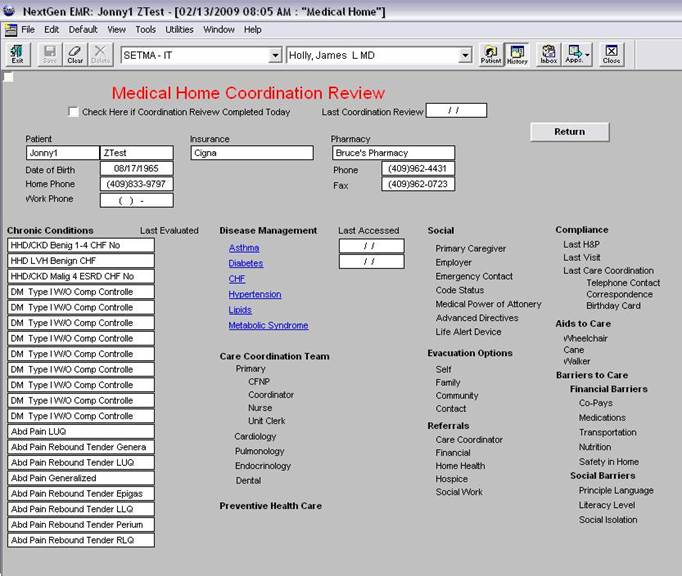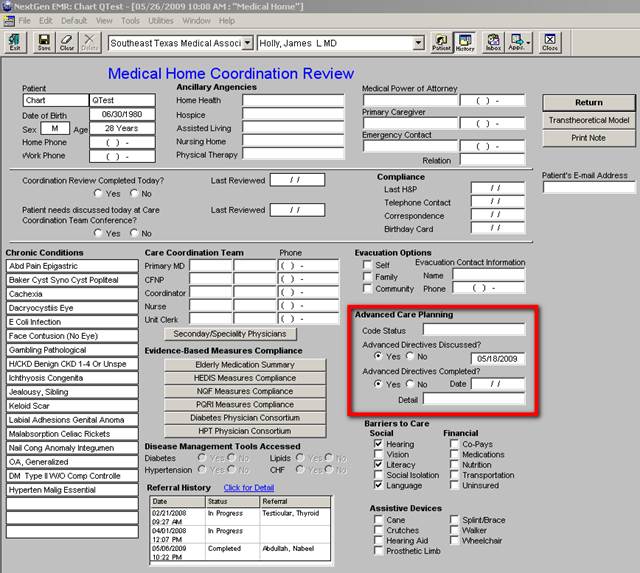|
From May, 1999 to May, 2009, SETMA built tools and designed a model of care which laid the foundation of a patient-centered medical home. In June of 2015, as SETMA adds the crown of Behavioral Health to our medical home model, we have met the standards of excellence of all organizations which recognize and/or accredit PC-MH. Yet as we celebrate this achievement, we recognize that those standards of excellence continue to evolve such that as we complete one process of achievement, we face the fact that that process has already changed.
Now, six years after we began the aggregation of SETMA’s tools into a medical home after ten years of building those tools (1999-2009), it is worthwhile to review the beginning of this journey and the end-point at which we have arrived, even as we continue the journey in anticipation of going through the recognition and accreditation process again between July, 2016 and June 2017.
Reviewing the Beginning
On February 17, 2009, four SETMA colleagues attended a physician-leadership conference in Houston to hear an introduction to the concept of a Patient-Centered Medical Home. Conducted by two representatives of the American Academy of Family Practice, the conference raised more questions than it answered. On February 19, 2009, the first of this series of ten articles on Medical Home, entitled, Part I: Is it the future of healthcare? appeared in The Examiner. Thus began SETMA’s 15-week journey through a maze of information, publications and discussions about what a “medical home” is.
On February 18, 2009, at 7:00 AM, Dr. Holly sent the following note to SETMA’s team:
“As I lay in bed last night thinking about the Medical Home, I got up and recorded a few thoughts some of which are below. This begins to answer for me the issue which I raised last night. If we accomplish what I have briefly outlined below and if we implement its use, after fleshing it out so that it is comprehensive, I think we will take all of the elements of Medical Home, all of which we already do and we will create the synergy which Medical Home promises. We are a very long way away, but this is a first step.”
The question he asked last night, which was not answered, was, “If we are doing everything you say that a Medical Home should do, and if we are not now a Medical Home, which I am confident that we are not, what is missing?” No one could answer that question but it continued to plague us.
It became apparent, and it became the focus of SETMA’s design, that there are two core issues to Medical Home:
- The patient is the central focus and it is the intent of Medical Home to engage the patient in their own care, empowering them with knowledge and ability to direct and evaluate the quality of that care.
- The coordination of care must now be “intentional” rather than simply “incidental” to other forms of care. At each visit, the primary care provider must have as his/her goal, the organization and completion of care in three areas: preventive care, acute care and chronic care.
As a result, the February 18th note continued with the following comment:
“...The below is what is missing from our discussion last night. The “connector” for all of the elements of care which we are doing is the Medical Home Care Coordination Database and Review which we do not have.”
At 10:13 AM, on that February 18th morning, SETMA published the following preliminary view of the Medical Home Coordination of care:

When compared with the layout and functionalities of the completed Coordination of Care Review template which is reviewed below, it will be seen how this process slowing began to give form and substance to the comprehensive coordination of patient care.
On April 14, 2009, Dr. Holly summarized some of our progress with the following note:
“Yesterday, I asked my assistant to tally the number of pages of materials which we have possessed in our Medical Home pilgrimage. I was amazed to learn that it is 2,280 pages, contained in 9 notebooks with material from NCQA, CMS, NQF, and PQRI, along with over 600 pages of materials which have been produced and written by SETMA staff. This has been a prodigious effort and a Herculean project. We are virtually at the end of the beginning.
“...by the end of this year, at the very latest, we expect to have incorporated into our EMR and into our work flow evidence-based standards and structure of healthcare , with the capacity for each provider to daily evaluate their own performance at the point-of-care, from:
- Healthcare Effectiveness Data and Information Set (HEDIS)
- National Committee on Quality Assurance (NCQA)
- National Quality Forum (NQF)
- Physician Consortium for Physician Performance Improvement (PCPPI)
- Physician Quality Reporting Initiative (PQRI)
- Patient Centered Medical Home (PCMM) €“ in process, application to be submitted in September
- E-prescribing”
As of June 2, 2009, all of the above was completed and the data to support the NCQA application was being collected daily.
The following is the Medical Home Coordination Review template. Comparing this with the preliminary template from February 18th it was obvious how far we had come. This template had been in use for over a month and all of SETMA’s colleagues were becoming experienced in how to use it.

By the end of June, 2009, all of SETMA’s healthcare providers and some all of our nurses had completed the review and study of a 99-page tutorial on how to effectively use this template in the performance of the Coordination functions of Medical Home. In addition, each had completed a comprehensive test on this tutorial indicating their knowledge of its content and of how to use this tool in the midst of seeing patients.
In addition, all have reviewed a shorter, 7-page tutorial, on how o complete the evidence-based preventive health care and patient evaluation measures required by NCQA, which had not traditionally been part of routine patient care, but which were a critical part of the intentional, patient-centered medical home, improvement of patient care.
Auditing Provider Performance
For the next two-weeks, In July, 2009, SETMA’s information technology department staff (IT) was involved in installing and in being trained on the use of a robust “data mining” software tool which will enable providers to know “how they are doing.”
When this training was completed, all members of SETMA’s healthcare team received a daily audit on the patient encounters from the previous day. These audits were automated and were reported to each provider at 6:00 AM. Each month, SETMA’s aggregate data on all patients seen was posted to www.jameslhollymd.com so that all of our patients could know how SETMA was performing and how SETMA was improving in our quest to become an effective Medical Home.
This was not an easy process, but the result improved the care for all of our patients. That was worth the energy, effort and resources which SETMA put into this process. At that time, we looked forward, as now we look back, reporting in the fall that SETMA had been recognized by NCQA as a Tier III Medical Home. It took until May, 2010 to complete the task. In 2013, SETMA renewed our NCQA recognition and in 2016, we will complete that recognition process for the third time. In that time, SETMA has added accreditation by the Accreditation Association for Ambulatory Health Care (AAAHC), URAC and the Joint Commission, becoming the only practice in America to achieve recognition and accreditation by all four organizations. During that time, we have continued to work toward providing the best care possible to and for our patients, which is the only care they deserve.
|